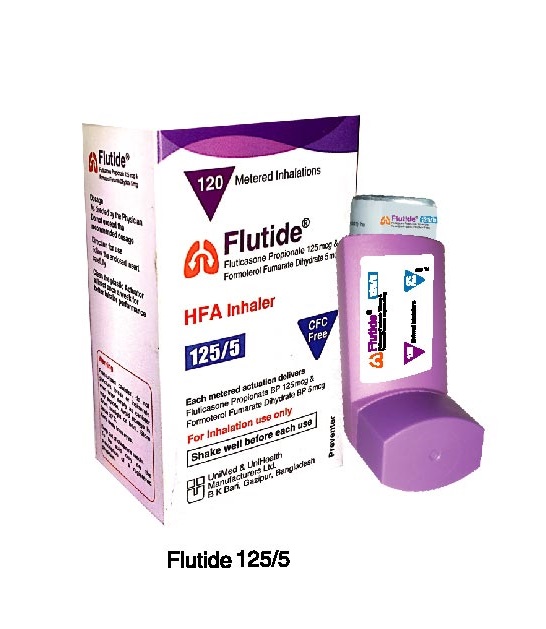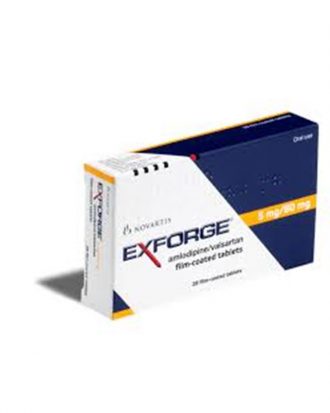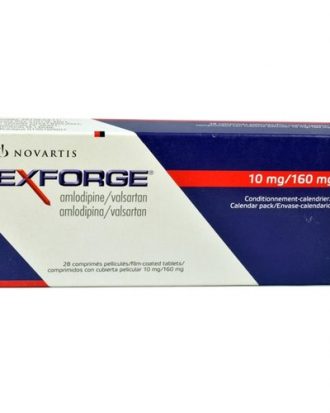Flutide HFA (Inhaler) 125/5
৳ 625.00
Indications
- For patients not adequately controlled with inhaled corticosteroids and “as required” inhaled short-acting ß2 agonist. Or,
- For patients already adequately controlled on both an inhaled corticosteroid and a long-acting ß2 agonist.
Fluticasone Propionate 125 mcg and Formoterol Fumarate 5 mcg inhaler are indicated in adults and adolescents aged 12 years and above.
COPD: Fluticasone Propionate and Formoterol Fumarate is recommended when a long-acting ß2 agonist/Inhaled corticosteroid is indicated & patients are unable to use other long-acting ß2 agonist/Inhaled corticosteroid.
Fluticasone Propionate 125 mcg and Formoterol Fumarate 5 mcg inhaler is indicated in adults only.
Therapeutic Class
Pharmacology
- Fluticasone propionate which belongs to a group of medicines called steroids. Steroids help to reduce swelling and inflammation in the lungs.
- Formoterol fumarate dihydrate which belongs to a group of medicines called long-acting beta 2 agonists. Long-acting beta 2 agonists are long-acting bronchodilators which help the airways in your lungs to stay open, making it easier for you to breathe.
Together these two active ingredients help to improve your breathing. It is advised that you should use this medicine every day as directed by your doctor or asthma nurse.
This medicine helps to prevent breathing problems such as asthma and helps to stop you becoming breathless and wheezy. However, it does not work if you are already having an asthma attack i.e. you are already breathless and wheezing. You will need to use a fast acting ‘reliever’ medicine such as salbutamol if this happens.
Dosage & Administration
Patients should be given the strength of this inhaler containing the appropriate Fluticasone Propionate dosage for the severity of their disease.
Asthma:
Fluticasone Propionate 125 mcg & Formoterol Fumarate 5 mcg inhaler only
- Recommended dose for adults and adolescents aged 12 years and above: Two inhalations (puffs) twice daily normally taken in the morning and in the evening.
- For adults only: The total daily dose can be further increased if asthma still remains poorly controlled by administering the highest strength of this combination product- i.e. Fluticasone Propionate 250 mcg & Formoterol Fumarate 10 mcg inhaler- two inhalations (puffs) twice daily. This highest strength is for use in adults only; it should not be used in adolescents aged 12 years and above.
- Children under 12 years: No data are available for this strength of this inhaler in children.
- This inhaler in any strength is not recommended for use in children less than 12 years of age.
Fluticasone Propionate 250 mcg & Formoterol Fumarate 10 mcg inhaler only
- Recommended dose for adults: Fluticasone Propionate 250 mcg & Formoterol Fumarate 10 mcg inhaler- two inhalations (puffs) twice daily normally taken in the morning and in the evening.
- Adolescents under 18 years and children: No data are available for this strength of this inhaler in children or adolescents. This inhaler in any strength is not recommended for use in children less than 12 years of age.
- This inhaler 250 microgram/10 microgram per actuation should not be used in adolescents.
COPD
Fluticasone Propionate 250 mcg & Formoterol Fumarate 10 mcg, two inhalations (puffs) twice daily normally taken in the morning and in the evening.
Interaction
Contraindications
The prophylactic use of this inhaler in exercise-induced asthma has not been studied. For such use, a separate rapid-acting bronchodilator should be considered. Patients should be reminded to take their this inhaler maintenance dose as prescribed, even when asymptomatic. Patients should not be initiated on this inhaler during an exacerbation, or if they have significantly worsening or acutely deteriorating asthma. Serious asthma-related adverse events and exacerbations may occur during treatment with this inhaler. Patients should be asked to continue treatment but to seek medical advice if asthma symptoms remain uncontrolled or worsen after initiation on this inhaler.
This inhaler should not be used as the first treatment for asthma.
This inhaler should be administered with caution in patients with pulmonary tuberculosis, quiescent tuberculosis or patients with fungal, viral or other infections of the airway. This inhaler should be used with caution in patients with thyrotoxicosis, phaeochromocytoma, diabetes mellitus, uncorrected hypokalaemia or patients predisposed to low levels of serum potassium, hypertrophic obstructive cardiomyopathy, idiopathic subvalvular aortic stenosis, severe hypertension, aneurysm or other severe cardiovascular disorders, such as ischaemic heart disease, cardiac arrhythmias or severe heart failure. Caution must be observed when treating patients with existing prolongation of the QTc interval. Formoterol itself may induce prolongation of the QTc interval.
As for all ß2 agonists, additional blood sugar controls should be considered in diabetic patients. As with other inhalation therapy paradoxical bronchospasm may occur with an immediate increase in wheezing and shortness of breath after dosing. This inhaler should be discontinued immediately, the patient assessed and alternative therapy instituted if necessary.
Systemic effects may occur with any inhaled corticosteroid, particularly at high doses prescribed for long periods. These effects are much less likely to occur than with oral corticosteroids. Possible systemic effects include Cushing’s syndrome, Cushingoid features, adrenal suppression, growth retardation in children and adolescents, decrease in bone mineral density, cataract glaucoma and more rarely, a range of psychological or behavioural effects including psychomotor hyperactivity, sleep disorders, anxiety, depression or aggression (particularly in children). It is important, therefore, that the patient is reviewed regularly and the dose of inhaled corticosteroid is reduced to the lowest dose at which effective control of asthma is maintained.
Side Effects
Pregnancy & Lactation
Breastfeeding: It is not known whether Fluticasone Propionate or FormoterolFumarateare excreted in human breast milk. Therefore, a decision must be made whether to discontinue breastfeeding or to discontinue/abstain from this inhaler therapy taking into account the benefit of breastfeeding for the child and the benefit of therapy for the woman.
Fertility: There are no data available on effects on fertility following administration of this inhaler. In animal studies, no effects on fertility have been seen following administration of the individual active substances at clinically relevant doses.
Use in Special Populations
Hepatic or renal: There are no data available for use of this inhaler in patients with hepatic or renal impairment.
Paediatric population: It is recommended that the height of children receiving prolonged treatment with inhaled corticosteroids is regularly monitored. If growth is slowed, therapy should be reviewed with the aim of reducing the dose of inhaled corticosteroid, if possible, to the lowest dose at which effective control of asthma is maintained. In addition, consideration should be given to referring the patient to a paediatric respiratory specialist.
Only limited data are available in respect of the use of this inhaler in children under 12 years of age. This inhaler is not recommended for use in children under 12 years of age until further data become available.
Overdose Effects
FormoterolFumarate: An overdose of Formoterol would likely lead to an exaggeration of effects that are typical for ß2 agonists; in which case the following adverse experiences may occur: angina, hypertension or hypotension, palpitations, tachycardia, arrhythmia, prolonged QTc interval, headache, tremor, nervousness, muscle cramps, dry mouth, insomnia, fatigue, malaise, seizures, metabolic acidosis, hypokalaemia, hyperglycaemia, nausea and vomiting.
Fluticasone Propionate: Acute overdose with Fluticasone Propionate usually does not constitute a clinical problem. The only harmful effect after inhalation of a large amount of the drug over a short period is suppression of hypothalamic pituitary adrenocortical (HPA) axis function. HPA axis function usually recovers in a few days, as verified by plasma cortisol measurements. Treatment with the inhaled corticosteroid should be continued at the recommended dose to control asthma.






Reviews
There are no reviews yet.